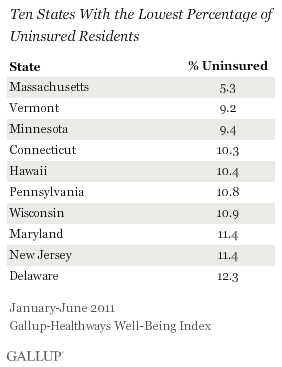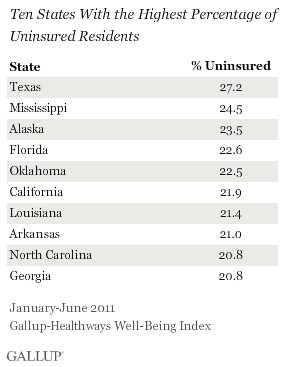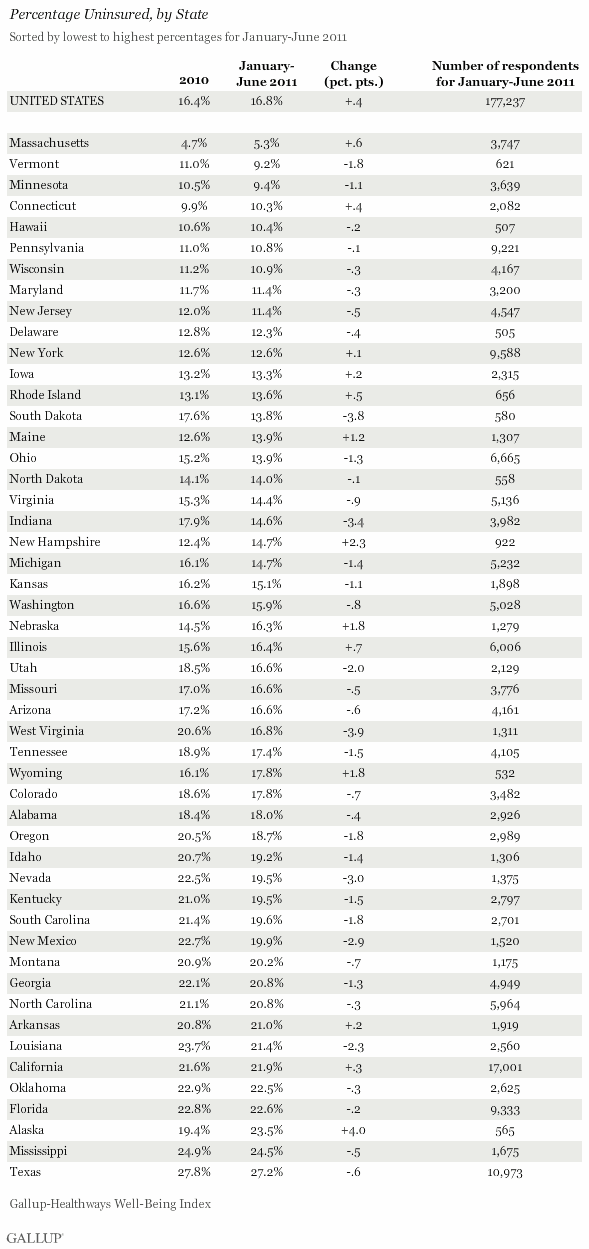WASHINGTON, D.C. -- Texas residents continue to be the most likely in the United States to lack health coverage, with 27.2% reporting being uninsured in the first half of 2011. At the other end of the spectrum is Massachusetts, where health insurance is required and 5.3% of residents lack coverage. These two states have represented the upper and lower bounds of uninsured rates since Gallup and Healthways started tracking coverage in 2008.


These results are based on 177,237 interviews conducted daily from January through June 2011 as part of the Gallup-Healthways Well-Being Index. An average of 16.8% of all American adults were uninsured in the first half of 2011, similar to the 16.4% in 2010. This percentage, however, has been edging up each year since 2008, at which time 14.8% of adults were uninsured. The percentage of uninsured residents in all states so far in 2011 is on par with 2010, but in most states remains higher than in 2008.
See page 2 for uninsured rates for all states.
Southern and Western States Still See Highest Uninsured Rates
States in the South and West continue to have higher numbers of uninsured adults than do those in the Northeast -- consistent with what Gallup found in 2008, 2009, and 2010. Eight of the 10 states with the highest uninsured rates in the country are in the South and the other two -- California and Alaska -- are in the West.
Texas, California, and Florida -- all three of which have an uninsured rate higher than 20% -- have disproportionately large Hispanic populations, the demographic group Gallup finds to be the most likely to be uninsured.
Uninsured rates are lower in the Northeast, with 7 of 10 states with the fewest uninsured residents located there, as in past years.
Bottom Line
Uninsured rates across states in 2011 appear to be relatively stable so far compared with 2010, but remain higher than in 2008. This could be seen as good news at a time when states are grappling with deep budget cuts and the implementation of new regulations and programs required under the Affordable Care Act. However, more than 10% of adults lack healthcare coverage in almost all states, with more than 15% going uninsured in 29 states. The fate of uninsured rates in America remains precarious as numerous states are challenging the legality of the new healthcare law in court. Gallup and Healthways monitor Americans' health insurance coverage daily and will continue to report on the trend throughout the year.
This story is part of a series of midyear updates on Gallup's State of the States data. Gallup.com will report new full-year totals in early 2012 based on all 2011 surveys.
About the Gallup-Healthways Well-Being Index
The Gallup-Healthways Well-Being Index tracks U.S. and U.K. well-being and provides best-in-class solutions for a healthier world. To learn more, please visit well-beingindex.com.
Survey Methods
Results are based on telephone interviews conducted as part of the Gallup-Healthways Well-Being Index survey Jan. 2-June 30, 2011, with a random sample of 177,237 adults, aged 18 and older, living in all 50 U.S. states and the District of Columbia, selected using random-digit-dial sampling.
For results based on the total sample of national adults, one can say with 95% confidence that the maximum margin of sampling error is ±0.2 percentage points. The margin of sampling error for most states is ±1-2 percentage points, but as high as ±4 points for smaller states such as Wyoming, North Dakota, South Dakota, Nebraska, and Hawaii.
The Gallup-Healthways Well-Being Index categorizes the District of Columbia as a congressional district.
Interviews are conducted with respondents on landline telephones and cellular phones, with interviews conducted in Spanish for respondents who are primarily Spanish-speaking. Each sample includes a minimum quota of 400 cell phone respondents and 600 landline respondents per 1,000 national adults, with additional minimum quotas among landline respondents by region. Landline telephone numbers are chosen at random among listed telephone numbers. Cell phone numbers are selected using random-digit-dial methods. Landline respondents are chosen at random within each household on the basis of which member had the most recent birthday.
Samples are weighted by gender, age, race, Hispanic ethnicity, education, region, adults in the household, and phone status (cell phone only/landline only/both, cell phone mostly, and having an unlisted landline number). Demographic weighting targets are based on the March 2010 Current Population Survey figures for the aged 18 and older non-institutionalized population living in U.S. telephone households. All reported margins of sampling error include the computed design effects for weighting and sample design.
In addition to sampling error, question wording and practical difficulties in conducting surveys can introduce error or bias into the findings of public opinion polls.
For more details on Gallup's polling methodology, visit www.gallup.com.

